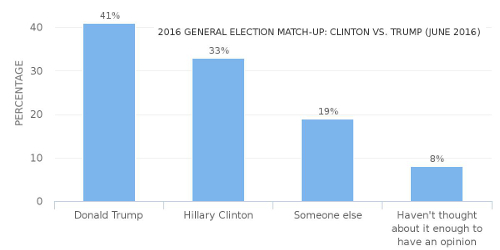Poll #2 is in the books.
Presumptive Republican presidential nominee Donald Trump leads Democratic rival Hillary Clinton by 8 percentage points in Texas, according to a University of Texas/Texas Politics Project Poll released Monday.
Trump is ahead of Clinton 41 percent to 33 percent in a head-to-head matchup, the poll found. Nineteen percent indicated support for “someone else,” and 8 percent said they “haven’t thought about it enough to have an opinion.”
Trump’s advantage over Clinton narrows to 7 percentage points when Libertarian Party nominee Gary Johnson was added to the choices. He garners 7 percent support, leaving Trump with 39 percent and Clinton with 32 percent.
Asked about their reasoning, 55 percent of the Trump supporters said they don’t want Clinton to become president, while 45 percent said they made their choice because they want Trump in the White House. Among Clinton supporters, 57 percent said they want her to be elected, while 43 explained their choice as a vote against Trump.
The two candidates remain very unpopular: 56 percent of the poll respondents have an unfavorable opinion of Trump, and 59 percent have an unfavorable impression of Clinton. They aren’t crazy about the political parties, either: 50 percent have an unfavorable opinion of the Democratic Party, and 51 percent have an unfavorable view of the Republican Party.
That last paragraph is a somewhat inaccurate statement of the landscape. Here is the Texas Politics Project page on the poll, and here is their description of the favorability numbers:
Attitudes toward both Clinton and Trump suggest that while both parties, to oversimplify, have some healing to do, the Democratic Party’s situation is, however stubborn, a bit more straightforward. Sanders’ supporters remain slow to warm to Clinton, especially in the conspicuous absence of leading-by-example from their candidate. Nonetheless, among all Democrats, Clinton’s favorability rating is 67 percent favorable and 19 percent unfavorable. Among self-described liberals, she’s only slightly weaker (65/25). As a group, Clinton voters hold a strongly positive view of their party with 75 percent viewing it favorably and only 9 percent holding an unfavorable view. Here, too, there are still some Berns to be healed: Among Sanders’ supporters in the primary, 44 percent have a favorable view of the Democratic Party, while 36 have an unfavorable view, potentially the result of the widespread suspicion among Sanders’ supporters that the party did not give their man a fair shake in the primaries.
Trump’s situation is more complicated, evidenced in the skepticism toward the Republican Party among supporters of the final two candidates in the GOP primaries. In stark contrast to Clinton supporters’ views of the Democratic Party, only 50 percent of Trump voters held a favorable view of the Republican Party, while almost a third (31 percent) held an unfavorable view. Attitudes were slightly worse among Cruz supporters, among whom 45 percent viewed the party favorably with 36 percent holding an unfavorable view.
Among important subgroups of the party, 68 percent of self-identified conservatives said that they would vote for Trump, with 21 percent saying they would vote for someone else – likely the home of a (very) small trove of libertarian votes, but just as likely a group that will eventually come home to Trump given their views of the alternative. Among whites, 54 percent supported Trump, with another 20 percent opting for “someone else,” also a very likely source of votes to return to Trump as long as Clinton is the only major alternative. A result among Republican constituencies that stands out: Trump is viewed less favorably by those who identify with the Tea Party (51 percent favorable / 35 percent unfavorable) than by Republicans who don’t call themselves Tea Partiers (62 percent favorable / 22 percent unfavorable).
Another way to put this is that as noted in the first paragraph above, Clinton’s favorables among Democrats are 67-19, while Trump’s among Republicans are 53-32. As they say on Mythbusters, there’s your problem. My guess is that in another two or three months, Clinton’s numbers among Dems will have improved more than Trump’s numbers among Rs have.
Poll #1 data is here. If there are crosstabs, I can’t find them, so again I can’t tell you how each candidate did with various subgroups. As with my statement above, my expectation is that both candidates’ overall numbers will increase as their favorables among their own partisans do. We now have two polls that show a single digit lead for Trump in Texas, but it’s early enough and there are far too many “unknown/other” respondents to put too much weight into that just yet. I’m delighted to have numbers to mull over, but they’re just laying down a baseline for now. I hope we can begin establishing some trends in the next couple of months.

